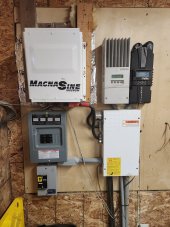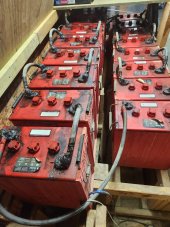Hello,
I bought an off grid home about a year ago and am interested in updating and upgrading the current system, which is 10 - 12 years old. I am new to solar, so not sure what all my equipment even is. But as I understand it...
*My current set up*
6 - evergreen solar 210w panels
6 - LG 300w panels
16 - 468ah 6v rolls s605 batteries
1- xentrex charge controller
1- midnite classic charge controller
- MagnaSine inverter?
- midnite control panel? MNDC250
Not exactly sure what the MagnaS unit is or the midnite control panel? One I assume is an Inverter and the other maybe battery monitoring system?
Either way, the main short coming I've learned with this set up, is that my batteries seem to drain quite fast. I suspect they may be at the end of their life being 10+ year old lead acid batteries. Also I feel like my PV set up is a little under sized.
*The upgrade*
So I'm considering upgrading from lead acid to lifepo4 eg4 server rack batteries And adding some new panels to my PV array.
However, can I simply remove my old lead acid batteries and install the new eg4 batteries with minimal to no changes? Or do I need a total system rework?
Also to add more PV panels will I need more charge controllers? More inverter? How do I figure this out?
If it helps, I figured my house on a heavy usage day will consume around 34kwh
Thanks in advance for any help!

I bought an off grid home about a year ago and am interested in updating and upgrading the current system, which is 10 - 12 years old. I am new to solar, so not sure what all my equipment even is. But as I understand it...
*My current set up*
6 - evergreen solar 210w panels
6 - LG 300w panels
16 - 468ah 6v rolls s605 batteries
1- xentrex charge controller
1- midnite classic charge controller
- MagnaSine inverter?
- midnite control panel? MNDC250
Not exactly sure what the MagnaS unit is or the midnite control panel? One I assume is an Inverter and the other maybe battery monitoring system?
Either way, the main short coming I've learned with this set up, is that my batteries seem to drain quite fast. I suspect they may be at the end of their life being 10+ year old lead acid batteries. Also I feel like my PV set up is a little under sized.
*The upgrade*
So I'm considering upgrading from lead acid to lifepo4 eg4 server rack batteries And adding some new panels to my PV array.
However, can I simply remove my old lead acid batteries and install the new eg4 batteries with minimal to no changes? Or do I need a total system rework?
Also to add more PV panels will I need more charge controllers? More inverter? How do I figure this out?
If it helps, I figured my house on a heavy usage day will consume around 34kwh
Thanks in advance for any help!





